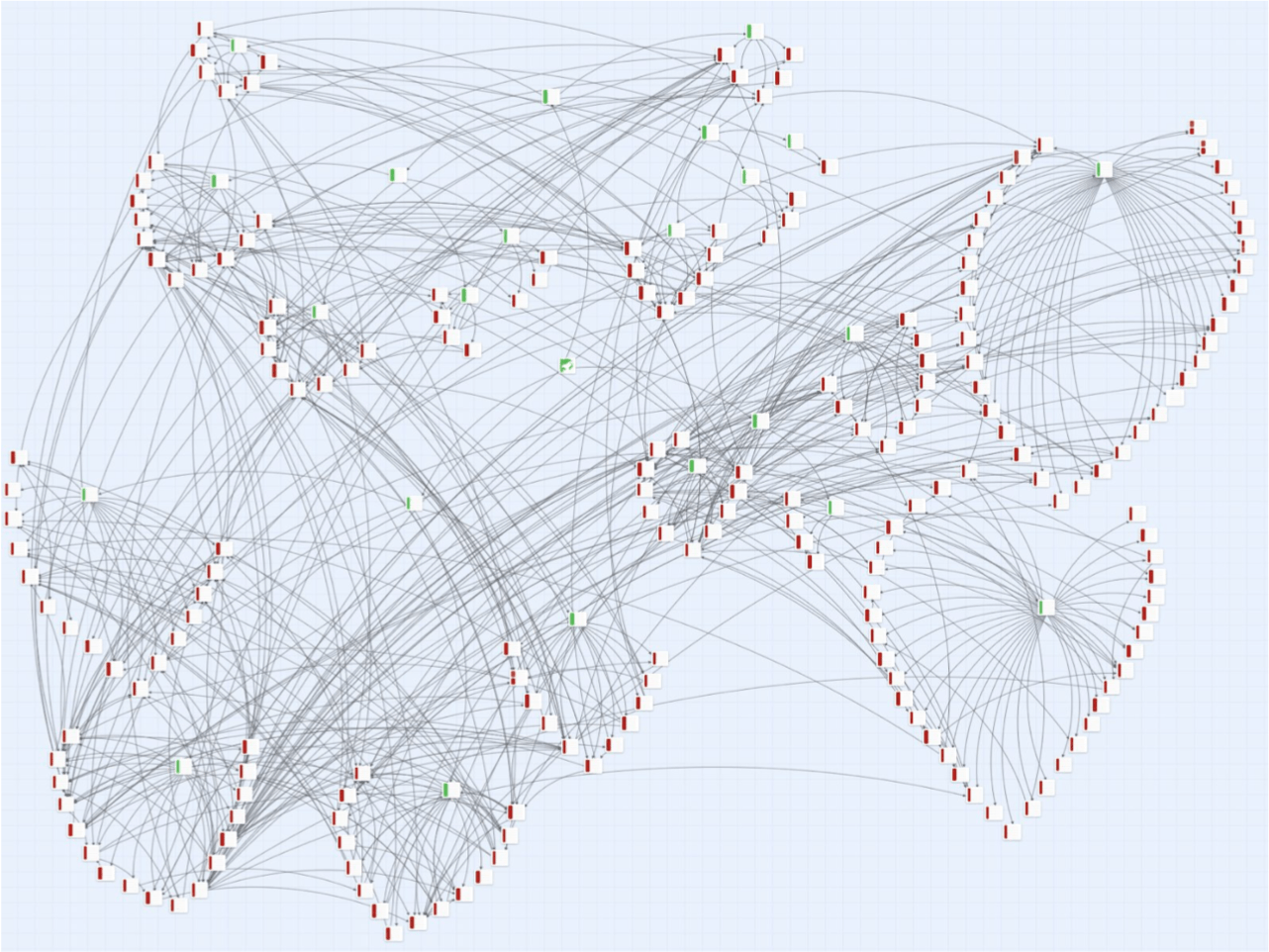I’m nearing the end of my first week at DSHI 2019! I’ve been taking “Introduction to Computation for Literary Criticism” with David Wrisley and Randa El Khatib. They have been extraordinarily helpful in introducing me (and the rest of the class) to a wide array of tools and methods for thinking about text visualizations, networks, mapping and stylometry. Below, I’ve attached several images with some preliminary explorations of how I might used data visualizations to explore the “mpreg” (male pregnancy) trope in fan fiction writing. The corpus that I’m working with draws from the Teen Wolf (TV) fandom on Archive of Our Own (AO3).
Author: Jon Heggestad (page 2 of 3)
My last several posts have looked at how I’ve created digital essays through Twine (an online tool designed for writers of hypertext fiction). In this post, I’ll outline another affordance that I’ve recently made through this platform.
I spent the majority of 2018 studying for my oral exams at Stony Brook University. I read hundreds of texts, ranging from Victorian poems to queer experimental reading to algorithmic criticism, and realizing early on that I was going to have a hard time keeping track of all of my notes and, more importantly, remembering the connections I’d made between all of these texts. As a solution, I turned to Twine and its ability to organize non-linear connections as a way to build my own database for studying.
Donna Haraway’s manifesto (for cyborgs… she has others as well) quickly became a staple feminist text. The ideas she raised in this 1985 publication have been endlessly discussed in the 30 years since. In my online, exploratory breakdown of this influential work, I attempt to lay out a map for navigating the ideas (or at least some of the ideas) that Haraway first addressed. Try out the game.
Play: Who’s It Gonna Be? A Digital Essay presented through Twine.
The boundaries between technology and romance are getting harder and harder to locate, what with the advent of popular dating apps and an increasing number of video game dating simulators. Here to celebrate this queerness, I’ve created a Twine game that connects the research I’ve done on these blurred boundaries in a rhizomatic fashion that’s just perfect for DH. In this game, you’ll find me considering a number of ways that digital scholars have approached this issue, as well an offering of my own (sort of my own… it’s appropriating).
Watching clips from danah boyd’s recent talk (“What Hath We Wrought?”) at the SXSW EDU conference had me worried. It’s ironic, however, in that my worry turns out to be a product of how these clips were framed by Goldie Blumenstyk, a writer for The Chronicle of Higher Education.

IKEA Effect: I made a *slight* modification to the Grindr logo ALL BY MYSELF.
Copyright law has never seemed so interesting and relevant. Thanks, Lessig. In Remix: Making Art and Commerce Thrive in the Hybrid Economy, Lawrence Lessig ultimately argues that copyright, as it currently stands, must be reformed. He portrays it as an archaic form of the law that no longer makes sense (questioning it ever did) in today’s digital climate, hindering both creativity and the economy more broadly.
In analyzing current copyright laws, Lessig identifies an important distinction between two forms of economic trade. There are commercial economies—the ones my mind immediately goes to—in which “money or ‘price’ is a central term of the ordinary, or normal, exchange,” i.e. those transactions in which monetary exchange is expected. I’ll pay you this much for that. In juxtaposition with this form of trade are sharing economies. According to Lessig, “Of all the possible terms of exchange within a sharing economy, the single term that isn’t appropriate is money.” He gives the example of a friendship to illustrate this idea, saying that there are certain expectations that you can have of a friend (“Spend more time with me!”), but the second you demand money in exchange for your friendship, “the relationship is no longer a friendship.”

Hannah More’s “The Shepherd of Salisbury Plain” was widely known and satirized in 19th-century England.
As a vestige of a Victorianist, I’ve often found ephemera studies to be fascinating. This began, I think, during my MA when I was studying the readership and publication history of Christian tracts in 19th-century England. Leah Price’s How to Do Things with Books in Victorian Britain had just come out, and in this work, she specifically examines the ephemeral quality of Christian tracts, portraying them as widely produced and distributed (by a pious upperclass) and then less widely read (by a lower class, involuntarily recipients). Yet, these texts still made a significant impression in Victorian culture; references to more “popular” tracts were widely known and easy to identify. In their rapid spread and equally rapid discarding, the tracts might be thought of as both ephemeral and viral.
Ephemera and the quick surges of popularity they produce become even more pronounced when observed in digital form. Mimicking our own fleeting interests and the identities they help to construct, digital ephemera seems equally tied up in changes, nostalgia, and sometimes-intentional erasure.
For this week’s post, I decided to do a tutorial of Dream Daddy (DD), the dad dating simulator video game that I’ve brought up a few times in class and in my blog post from three weeks ago. I found a number of relevant connections between this particular video game and the Fox article we read (“Reimagining the Avatar Dream: Modeling Social Identity in Digital Media”).
 The conversation below with Francesca Rodriguez Sawaya began at a workshop last month called “Weaving to Code, Coding to Weave,” which was Rodriguez Sawaya led alongside Renata Gaui. Both women are designers, weavers, coders, and recent graduates from the Interactive Telecommunications Program (ITP) at NYU Tisch. After the workshop, I got in touch with Rodriguez Sawaya in hopes that she’d be willing to expand on some of the ideas she’d introduced me to. She very generously agreed, and the following conversation serves as a preview for her wonderful insights on coding and weaving, how these technologies incorporate unique modes of storytelling, and the opportunities for empowerment that they might offer women.
The conversation below with Francesca Rodriguez Sawaya began at a workshop last month called “Weaving to Code, Coding to Weave,” which was Rodriguez Sawaya led alongside Renata Gaui. Both women are designers, weavers, coders, and recent graduates from the Interactive Telecommunications Program (ITP) at NYU Tisch. After the workshop, I got in touch with Rodriguez Sawaya in hopes that she’d be willing to expand on some of the ideas she’d introduced me to. She very generously agreed, and the following conversation serves as a preview for her wonderful insights on coding and weaving, how these technologies incorporate unique modes of storytelling, and the opportunities for empowerment that they might offer women.
This post provides background for and a preview of an interview I’ll be uploading later this week.
My little weaving was a little pathetic. My little coding wasn’t very impressive either. But the ideas being expressed and the connections between these acts and the potential for better understanding spaces for women’s empowerment made my sad little productions seem much grander than they really were.
Last week, I attended a workshop on Stony Brook’s campus called “Weaving to Code, Coding to Weave.” The event was led by Francesca Rodriguez Sawaya and Renata Gaui—designers, weavers, coders, and recent graduates from the Interactive Telecommunications Program (ITP) at NYU Tisch. According to the workshop’s promotional flyer, participants would “learn about the art of weaving to illustrate how the binary system works.” During the three-hour event, Rodriguez Sawaya and Gaui walked us through p5, a JavaScript library designed with artists in mind, and also taught us the basics of weaving. Continue reading
© 2025 Expected Turbulence
Theme by Anders Noren — Up ↑

